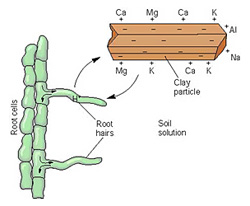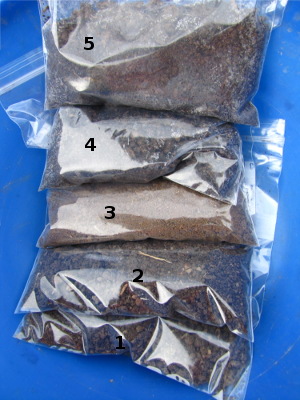
Cation exchange capacity
 Cation exchange capacity is
the first characteristic you should consider when you get your soil
test results. Cation exchange capacity (CEC for short) is
closely tied to the amount of organic matter and clay you have in
your soil since both provide spots for positively charged ions ---
cations --- to cling to the soil. In contrast, sandy soil without
much organic matter will allow
nutrients to leach away during heavy rains.
You're throwing away your money if you add soil supplements to raise
your calcium, magnesium, or potassium levels without first increasing
your CEC so that these essential nutrients will be held in place.
Cation exchange capacity is
the first characteristic you should consider when you get your soil
test results. Cation exchange capacity (CEC for short) is
closely tied to the amount of organic matter and clay you have in
your soil since both provide spots for positively charged ions ---
cations --- to cling to the soil. In contrast, sandy soil without
much organic matter will allow
nutrients to leach away during heavy rains.
You're throwing away your money if you add soil supplements to raise
your calcium, magnesium, or potassium levels without first increasing
your CEC so that these essential nutrients will be held in place.
So what's a good
CEC? CEC can range from 0 to 100 meq/100 g, and
your goal should be to reach or exceed 20 meq/100 g. Although
clay and any kind of organic matter will help you achieve this goal,
humus is the most effective since it provides a lot more cation
binding sites per unit area. In case you're not familiar with the
distinction, humus is organic matter that has broken down to a stable
point at which it may endure for hundreds or thousands of years.
To make humus, add any kind of organic matter to your soil (compost,
mulch, or cover crops) and make sure soil
conditions are right
for earthworms, bacteria, and fungi to turn that organic matter into
high quality humus.
Let's take a look at my
CEC and organic matter test results:
| Mule (1) | Mule (2) | CP3 (3) | Back (4) | Front (5) | Mom front | Mom back | |
| CEC | 65.6 | 74.4 | 15.6 | 56 | 47.1 | 27.9 | 36.3 |
| % OM | 17 | 18.4 | 8.2 | 15 | 14.6 | 15.9 | 14.1 |
I've highlighted the one non-garden spot I sampled --- our chicken pasture, which was basically a lawn until we started letting chickens graze there this spring. I also sampled some of my Mom's soil, which has been intensively gardened for decades. Finally, the white columns are four different parts of my own vegetable garden. By comparing these three areas, you can see:
 Within my garden, CEC values increase as
percent organic matter increases. Mark and I were both able to
line up our soil samples from most to least organic matter by eye, so
it would be possible to keep rough track of this information without
sending off soil samples.
Within my garden, CEC values increase as
percent organic matter increases. Mark and I were both able to
line up our soil samples from most to least organic matter by eye, so
it would be possible to keep rough track of this information without
sending off soil samples.
- Mom's CEC values are lower than mine even though her soil has just about as much organic matter. That's the difference between gardening in very clayey soil (my garden) and in a silty loam (her soil.)
- My pasture --- where I've never added compost --- is the only
area with a CEC below the 20 meq/100
g level. As I use more intensive
management techniques on this
pasture, I hope to raise the CEC without adding any soil amendments.
Most organic gardeners believe you can't have too much organic matter in your soil, but soil scientists will roll their eyes at that statement and now I understand why. If your CEC is low but your organic matter levels are high, that means you're doing something wrong and your organic matter isn't being broken down into a stable humus. Maybe you've added too much high carbon material all at once (for example, tilling wood chips into the soil) or have sprayed pesticides that killed off your soil microorganisms. That's why I recommend using CEC rather than organic matter as the most important "grade" on your holistic gardening "report card." As far as I can tell, with CEC, more is always better.
| This post is part of our Holistic Soil Test Analysis lunchtime series.
Read all of the entries: |
Want more in-depth information? Browse through our books.
Or explore more posts by date or by subject.
About us: Anna Hess and Mark Hamilton spent over a decade living self-sufficiently in the mountains of Virginia before moving north to start over from scratch in the foothills of Ohio. They've experimented with permaculture, no-till gardening, trailersteading, home-based microbusinesses and much more, writing about their adventures in both blogs and books.
Want to be notified when new comments are posted on this page? Click on the RSS button after you add a comment to subscribe to the comment feed, or simply check the box beside "email replies to me" while writing your comment.
